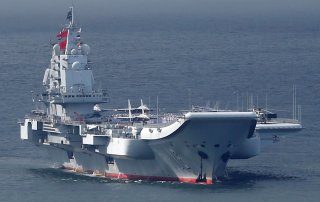China's First Aircraft Carrier Is Back in Action
After six years at sea, Liaoning -- now 30 years old -- sailed back to Dalian for her first refit. Carriers typically spend a third of their time undergoing maintenance, another third in training and the last third on operations.
The Chinese navy's first aircraft carrier Liaoning on Jan. 21, 2019 set sail from the port of Dalian in northern China after spending six months undergoing maintenance, state-run Global Times reported.
With Liaoning's return to service, the Chinese navy again has an operational flattop. Sister vessel Shandong is still undergoing trials in anticipation of commissioning in 2019 or 2020.
The Chinese fleet reportedly rushed work on Liaoning and Shandong so that both vessels are available for celebrations marking the 70th anniversary of the founding of the People’s Republic of China in October 2019.
There had been some worry in official circles in China that scandal at the China Shipbuilding Industry Corporation, which built Liaoning and Shandong, might slow work on the carriers.
The Chinese government reportedly fired CSIC manager Sun Bo in December 2018 amid an investigation in allegations that Sun had accepted bribes and passed secrets to foreign spies. Sun had overseen the Chinese navy's carrier program for more than a decade.
Liaoning's departure from Dalian coincided with a military exercise being run by the Maritime Safety Administration of China. The exercise was scheduled from Jan. 21 to Jan. 28, 2019 in the North Huanghai Sea near Dalian, Global Times reported.
Liaoning, a 999-feet-long former Ukrainian vessel that China acquired in the late 1990s, twice has deployed since commissioning in 2012. In late 2016 and early 2017, Liaoning and her wing of J-15 fighters plus escort ships deployed to the South China Sea where the carrier "conducted flight operations and task force operations that included transits of the Taiwan Strait and through the Philippine Sea," according to the U.S. Defense Department's 2018 report on Chinese military capabilities.
The ex-Ukrainian flattop deployed for another war game in the western Pacific in April 2018. The exercise east of the Bashi Channel in addition to Liaoning involved six surface warships, according to Jane's.
During that exercise, the carrier group practiced strike operations and defensive maneuvers aimed at “verifying the collaborative ability of the group's vessels and aircraft, examining the group's offensive and defensive systems and fostering the ability of commanders to make decisions when faced with complicated circumstances," according to state-run China Daily.
After six years at sea, Liaoning -- now 30 years old -- sailed back to Dalian for her first refit. Carriers typically spend a third of their time undergoing maintenance, another third in training and the last third on operations.
"Intense operations and the sea environment will inevitably result in degradation and corrosion of the ship," Global Times reported. "It is necessary for an aircraft carrier to undergo regular maintenance after several years of operation, including replacing parts and components with new ones in order to ensure the vessel functions properly."
Workers apparently also upgraded Liaoning's sensors and electronics, reportedly bringing them up to a standard more closely matching the newer, Chinese-built Shandong. The two vessels' main role in wartime is to provide air cover for other ships, according to the U.S. Defense Intelligence Agency.
"China’s current aircraft carrier and planned follow-on carriers will extend air-defense umbrellas beyond the range of coastal systems and help enable task group operations in far seas," the DIA reported in January 2019.
But even with upgrades and a possible wartime role, the Chinese navy still considers Liaoning to be a training vessel. Unlike other Chinese warships, Liaoning does not belong to any of the PLAN's regional fleets.
Shandong could be the first Chinese carrier to serve under a regional fleet. "The primary purpose of this first domestic aircraft carrier will be to serve a regional defense mission," the DIA claimed. "Beijing probably also will use the carrier to project power throughout the South China Sea and possibly into the Indian Ocean."
A third, apparently larger carrier is under construction in Shanghai and could commission in the mid-2020s. The Chinese navy could possess as many as six aircraft carriers by the mid-2030s, experts told state media.
The U.S. Navy possesses 11 aircraft carriers.
David Axe serves as the new Defense Editor of the National Interest. He is the author of the graphic novels War Fix, War Is Boring and Machete Squad.


